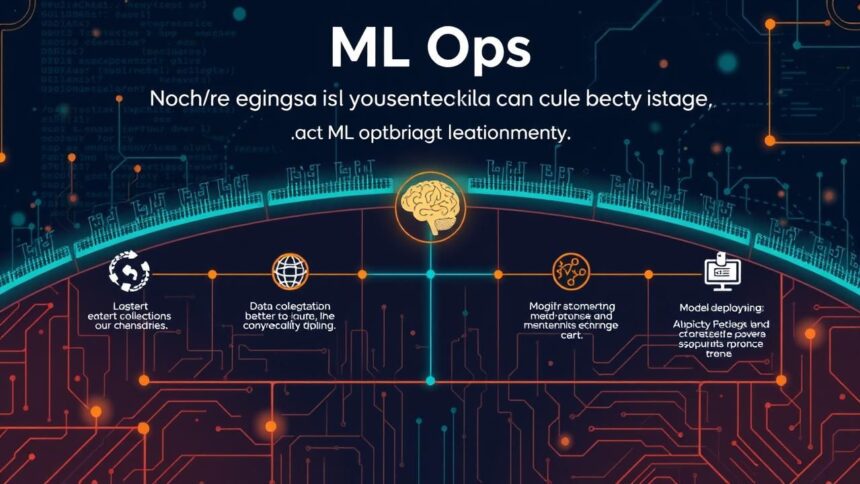Building Production-Ready ML Pipelines: A Practical Guide to ML Ops Implementation
Imagine this: you’ve just spent months perfecting your machine learning model. It’s brilliant—accurate, efficient, and just the boost your business needs. But here’s the thing: how do you get that model from your development environment into the real world, where it can actually make a difference? That’s where ML Ops, or machine learning operations, comes into play. Building production-ready ML pipelines is the cornerstone of ensuring your model’s success beyond the lab.
01. What is ML Ops and Why Does it Matter?
So, what exactly is ML Ops? In a nutshell, ML Ops is about streamlining the process of building, deploying, and maintaining machine-learning models. It’s an interdisciplinary field that combines data engineering, DevOps, and machine learning, creating a seamless workflow from data collection to model deployment and monitoring. Think of it as the glue that holds your ML projects together, ensuring they can scale and adapt as your business grows.
If you’re curious about why ML Ops matters, consider this. Your model might be a star in training, but the real world is messy. Data formats change, user behavior shifts, and hardware configurations vary. ML Ops helps you manage all these uncertainties, ensuring your model performs reliably over time.
01.1. The Core Pillars of ML Ops
In order to build robust ML pipelines, you need to understand the core pillars of ML Ops. Essentially, they include:
- Continuous Integration and Continuous Deployment (CI/CD): Automating the testing and deployment of your models ensures that new updates and fixes are integrated smoothly and quickly. This helps in maintaining a high level of accuracy and reliability.
- Monitoring and Logging: Keeping an eye on your models in real-time is crucial. You need to know when things go wrong, why they went wrong, and how to fix them. Monitoring and logging help you stay on top of your model’s performance.
- Versioning: It’s not just about versioning your code. ML Ops involves versioning data, models, and even environment configurations. This way, you can roll back to a previous version if something goes awry.
- Infrastructure Management: Efficiently managing the infrastructure where your models run is key. This includes scaling resources up or down based on demand and ensuring that your infrastructure is secure and compliant with relevant regulations.
02. Building Production-Ready ML Pipelines
Alright, now that you understand what ML Ops is about let’s dive into how to build a production-ready ML pipeline. This is where the rubber meets the road, and your model transitions from a promising experiment to a solid business asset. Here’s a step-by-step guide to help you through the process.
02.1. Step 1: Define Your Objectives
Before you dive in, it’s crucial to define what success looks like for your ML model. What problem are you solving? How will you measure success? Clear objectives will guide your entire pipeline and keep you focused. For example, if you’re building a recommendation engine, your objective might be to increase user engagement by 20% within six months.
02.2. Step 2: Data Collection and Preparation
Next up is data collection and preparation. Your model is only as good as the data it learns from. Here are some key steps:
- Data Collection: Gather data from all relevant sources. This might include databases, APIs, or even external datasets. Ensure you have the right permissions and compliance protocols in place.
- Data Cleaning: Cleaning your data is essential. This means handling missing values, removing duplicates, and fixing inconsistencies.
- Data Transformation: Transform your data into a format that your model can easily process. This might include normalization, encoding categorical variables, or aggregating data.
Once you’ve got your data in shape, it’s time to move on to training your model. Remember, the quality of your data significantly impacts your model’s performance, so don’t skimp on this step.
02.3. Step 3: Model Training and Evaluation
With your data prepped, it’s time to train your model. This involves selecting the right algorithm, tuning hyperparameters, and evaluating performance. Use techniques like cross-validation to ensure your model generalizes well to new data.
Once your model is trained, evaluate it using relevant metrics. For example, if you’re building a classification model, you might use accuracy, precision, recall, and F1-score. Don’t forget to visualize your results to get a better understanding of where your model might be falling short.
02.4. Step 4: Model Deployment
Deployment is where your model goes live. There are several ways to deploy a machine learning model, including:
- Batch Processing: Running your model on batches of data periodically.
- Real-Time Inference: Serving predictions in real-time, often through an API.
- Edge Deployment: Running your model on edge devices, such as IoT sensors or smartphones.
For real-time inference, you might use a service like AWS SageMaker, Google AI Platform, or Azure Machine Learning. These platforms offer tools for deploying, scaling, and monitoring your models.
When deploying, also consider the infrastructure. Will you use cloud services, on-premises servers, or a hybrid approach? Ensure your infrastructure can scale to handle increased load and is secure from potential threats.
02.5. Step 5: Monitoring and Maintenance
Deploying your model isn’t the end of the story. In fact, it’s just the beginning. Monitoring your model’s performance in the real world is crucial. Set up alerts for any anomalies, such as sudden drops in accuracy or unexpected data patterns.
Use logging to keep track of input data, model predictions, and any errors that occur. This data is invaluable for debugging and improving your model. Tools like Prometheus and Grafana can help you visualize your logs and monitor metrics in real-time.
Regularly retrain your model with new data to keep it up-to-date. Machine learning models can drift over time as data patterns change, so continuous learning is essential.
03. Best Practices for ML Ops Implementation
Implementing ML Ops effectively requires following some best practices. Let’s dive into some tips to help you get the most out of your ML pipelines.
03.1. Automate Where Possible
Automation is key in ML Ops. Automate repetitive tasks like data preprocessing, model training, and deployment. This not only saves time but also reduces the risk of human error. Use tools like Jenkins, GitLab CI, or CircleCI for continuous integration and deployment.
03.2. Use Containerization and Orchestration
Containerization tools like Docker help you package your model and its dependencies into a single unit. This ensures consistency across different environments, from development to production. For orchestration, use Kubernetes to manage and scale your containers.
03.3. Ensure Reproducibility
Reproducibility is crucial for debugging and improving your models. Use version control for your code, data, and model artifacts. Tools like DVC (Data Version Control) and MLflow can help you track changes and replicate experiments.
03.4. Document Everything
Documentation might not be the most exciting part of ML Ops, but it’s incredibly important. Document your data sources, preprocessing steps, model architectures, and deployment configurations. This makes it easier for others (or future you) to understand, maintain, and improve your pipelines.
Incorporate end-user documentation using shared documentation, code, and resources across the development lifecycle. This aligns initial use cases with current operational goals, offering better operational efficiency downstream.
03.5. Implement Security Best Practices
Security is a top priority in ML Ops. Ensure your data is encrypted both at rest and in transit. Use access controls to restrict who can view or modify your data and models. Regularly audit your infrastructure for security vulnerabilities and patches.
04. Common Challenges in ML Ops and How to Overcome Them
Building production-ready ML pipelines isn’t without its challenges. Here are some common hurdles and how to overcome them.
04.1. Data Quality Issues
Poor data quality is a frequent issue in ML. To mitigate this, implement robust data validation and cleaning processes. Use tools like Trifacta or Talend to automate data preparation. Regularly monitor data quality and set up alerts for any anomalies.
04.2. Model Drift
Model drift occurs when your model’s performance degrades over time due to changes in the data distribution. To combat this, monitor your model’s performance regularly and retrain it with fresh data. Use techniques like automated retraining pipelines to keep your model up-to-date.
04.3. Scalability Issues
As your business grows, your ML models need to scale accordingly. Use cloud services like AWS, Google Cloud, or Azure to scale your infrastructure on demand. Optimize your models and data pipelines for performance and cost-efficiency.
04.4. Collaboration and Communication
ML Ops involves multiple stakeholders, from data scientists to engineers to business analysts. Ensure clear communication and collaboration. Use tools like Slack, Confluence, or Jira to streamline workflows and keep everyone on the same page. Regular meetings and status updates can also help align goals and expectations.
05. Case Studies: Successful ML Ops Implementations
To get a better idea of how ML Ops can be implemented, let’s look at a couple of successful case studies.
05.1. Netflix’s Recommendation Engine
Netflix is renowned for its recommendation engine, which suggests movies and TV shows tailored to each user. The company uses ML Ops to ensure its models are always up-to-date and accurate. They leverage continuous integration and deployment to update their recommendation models frequently. Monitoring and logging help them quickly identify and fix issues. The result? A seamless user experience that keeps viewers engaged.
05.2. Uber’s ETA Prediction
Uber uses machine learning to predict ETAs (Estimated Time of Arrival) for rides. Their ML Ops implementation involves collecting and preprocessing massive amounts of data in real-time. They use containerization and orchestration to deploy models across their global infrastructure. Monitoring and retraining ensure their models remain accurate and reliable, providing a better user experience.
06: Moving Forward with ML Ops
Building production-ready ML pipelines through ML Ops is a journey, not a destination. As your business evolves, so will your models and the infrastructure supporting them. Embrace the iterative nature of ML Ops and continuously strive to improve.
06.1. Stay Updated with the Latest Tools and Technologies
ML Ops is a rapidly evolving field. Stay updated with the latest tools, technologies, and best practices. Attend conferences, webinars, and workshops. Join online communities and forums to learn from others and share your experiences.
06.2. Foster a Culture of Experimentation and Learning
Encourage a culture of experimentation and learning within your team. Failure is a part of the process, and every failure brings a learning opportunity. Celebrate successes and learn from mistakes. This will foster innovation and drive continuous improvement.
06.3. Collaborate and Communicate
Collaboration and communication are key to successful ML Ops. Break down silos between data science, engineering, and business teams. Work together to align goals, share knowledge, and solve problems. Regular meetings, status updates, and open channels of communication can help achieve this.
07. Conclusion: Building for the Future
Building production-ready ML pipelines through ML Ops isn’t easy, but it’s worth it. By streamlining your workflows, ensuring reproducibility, and monitoring performance, you can turn your ML experiments into robust business solutions. Embrace the challenges, learn from failures, and continuously strive to improve. Think of ML Ops not as a set of rules to follow but as a philosophy to adopt.
Just imagine that glorious feeling when your model takes off from the lab to thrive in the real world, continuously learning, adapting, and delivering value. You’ve invested time, effort, and even a little bit of your heart into this model. So, why not give it the best shot at success?
With the right approach and a bit of determination, you’re ready to tackle the world of ML Ops and build production-ready pipelines that stand the test of time. Good luck, and remember: every line of code and every data point is a step towards a brighter, more intelligent future.










